 Adding a heavy liquid to float waste in a Hanford tank so it could be pumped out was the most challenging step in preparing the tank to support 24/7 operations at a nearby facility that will start turning the waste into glass by the end of 2023.
RICHLAND, Wash. – An EM Hanford Site waste tank has been repurposed in support of the Direct-Feed Low-Activity Waste (DFLAW) program set to begin treating tank waste by the end of 2023.
Waste Tank AP-106 was emptied so that it can hold material bound for the Low-Activity Waste (LAW) Facility at the Waste Treatment and Immobilization Plant.
The 1.1-million-gallon tank will be used to receive waste that has been processed to remove radioactive cesium and solids. That “pretreated” waste in Tank AP-106 will then be transferred directly to the LAW Facility to be vitrified, a process in which the waste is turned into glass, and placed into shielded containers for disposal at the Integrated Disposal Facility on the Hanford Site.
“Preparing Tank AP-106 for its ‘waste-feed’ mission is a significant step forward in our transformation to a site that is operating around-the-clock to treat tank waste,” said Dusty Stewart, EM program manager for the Hanford tanks. “By the time the Low-Activity Waste Facility starts operating, we plan to have enough pretreated waste in this tank to support a year’s worth of vitrification.”
Removing the initial waste from the tank was not as easy as simply pumping the waste out, as the pump does not reach to the bottom of the tank. In several steps, 40,000 gallons of a heavy liquid were inserted under the waste in the tank to float the waste up to the level of the pump.
“It was technically difficult, but the team did it safely and efficiently,” said Ben Gallaher of Washington River Protection Solutions, the Hanford Site tank farm contractor. “We will be taking the lessons learned here as we continue the momentum of cleaning up the Columbia River corridor.
-Contributor: Hal McCune
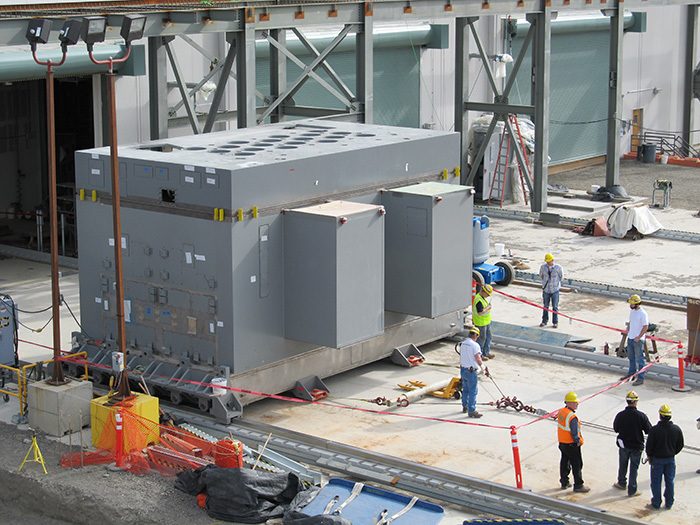 Crews pull a melter from Hanford’s Waste Treatment and Immobilization Plant (WTP) for inspection. WTP contractor Bechtel National, Inc. is purchasing engineered stainless-steel containers and a spare melter for the plant’s Low-Activity Waste Facility.
RICHLAND, Wash. – As EM Hanford’s Waste Treatment and Immobilization Plant (WTP) prepares for the Direct-Feed Low-Activity Waste (DFLAW) program to begin by the end of 2023, components are being sought now to support upcoming commissioning operations.
Those components include engineered stainless-steel containers, which will hold vitrified waste for safe long-term storage, and a spare melter for the WTP. Vitrified waste is waste mixed with molten glass.
“As we continue to transition the Hanford Site’s operational pace to support 24/7 operations, having the tools in place supports that effort,” said Tom Fletcher, the WTP federal project director. “Over the next several years, Hanford will undergo some dynamic changes and this is one more positive step in that direction.”
WTP contractor Bechtel National, Inc. (BNI) is purchasing the 7-foot-tall, 4-foot-wide containers that will be filled with molten glass mixed with simulated and real radioactive waste during WTP commissioning. BNI is also purchasing the melter that will be on standby for when the current melters reach the ends of their service lives.
 Workers install refractory brick inside a Low-Activity Waste (LAW) Facility vitrification melter at Hanford’s Waste Treatment and Immobilization Plant (WTP). During operations, the refractory brick will provide thermal insulation and structural support for the melter. WTP contractor Bechtel National, Inc., is purchasing engineered stainless-steel containers and a spare melter for the LAW Facility.
The containers will begin to arrive later this year, and the spare melter is targeted for delivery in the summer of 2021. The total cost of the new equipment is nearly $37.8 million.
“These specially engineered stainless-steel containers and the spare melter are critical to our ability to complete hot commissioning in just a few years,” said Valerie McCain, a BNI principal vice president and WTP project director.
WTP’s Low-Activity Waste (LAW) Facility is integral to the DFLAW program. The LAW Facility already contains two installed melters that will heat tank waste and glass-forming materials to 2,100 degrees Fahrenheit – the process of vitrification – before the mixture is poured into the containers for safe long-term storage. During operations, the LAW Facility will treat about 1.75 million gallons of tank waste per year.
LAW Facility construction is substantially complete; systems startup testing is well underway and the computerized control room is operational and staffed 24/7. Construction of the Analytical Laboratory and plant-wide utilities infrastructure is finished, and startup testing is nearing completion.
-Contributor: George Rangel
 Representatives of EM West Valley Demonstration Project (WVDP) and CH2M HILL BWXT West Valley (CHBWV) recognized Capt. James Madden for his lifesaving response to Cattaraugus County Sheriff’s Office Sgt. Jason Dry. From left, Anthony Lechanski, WVDP physical scientist; Scott Anderson, CHBWV president and general manager; Bryan Bower, WVDP director; Jennifer Dundas, WVDP safety and site programs team leader; Craig Rieman, WVDP deputy director; Madden, with Securitas Critical Infrastructure Services; Dry; John Bauer, CHBWV Board chair; John Rendall CHBWV deputy general manager; Joey Hoskins, CHBWV Board member; Ken Whitham, CHBWV vice president of environmental, safety, health, and quality; and Dave Schuman, CHBWV safeguards and security manager.
WEST VALLEY, N.Y. – The EM West Valley Demonstration Project (WVDP) commended the captain of the site’s security force in a ceremony last week for his lifesaving response to a member of the local sheriff’s office.
WVDP security officers and Cattaraugus County Sheriff’s Office representatives were having lunch at WVDP in January when Capt. James Madden observed Sgt. Jason Dry choking. Madden rushed to Dry and applied the Heimlich maneuver. After three attempts, a blockage was removed, allowing Dry to breathe freely.
“Captain James Madden’s immediate response to the emergency saved a life,” EM WVDP Director Bryan Bower said. “His dedication to duty and commitment to excellence resulted in his immediate reaction when faced with a life-and-death situation.”
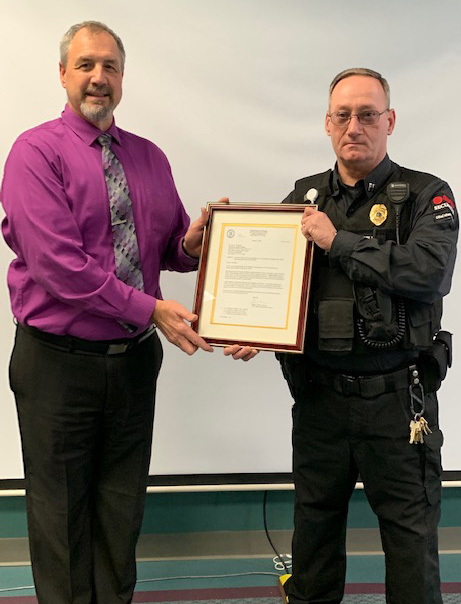 |
|
EM West Valley Demonstration Project (WVDP) Director Bryan Bower presents a plaque to Capt. James Madden during a ceremony at WVDP last week. Madden, who was recognized for his lifesaving actions, is an employee with Securitas Critical Infrastructure Services, a subcontractor to WVDP cleanup contractor CH2M HILL BWXT West Valley. |
Madden is an employee of Securitas Critical Infrastructure Services, a subcontractor to WVDP cleanup contractor CH2M HILL BWXT West Valley (CHBWV).
“For exemplary meritorious service to the community and to the WVDP, it would be my honor to recognize the actions taken by Captain Madden,” Bower said during the ceremony attended by Dry and representatives of WVDP and CHBWV. “I am very proud of him and recognize his valuable service to protecting the staff at the WVDP and the surrounding community.”
Ken Whitham, CHBWV vice president of environmental, safety, health, and quality, said Madden’s actions speak volumes to his knowledge and dedication to employees, WVDP visitors, and the greater public.
“He was able to put his knowledge and training into action to save the life of a coworker, and that is truly commendable,” Whitham said.
-Contributor: Joseph Pillittere
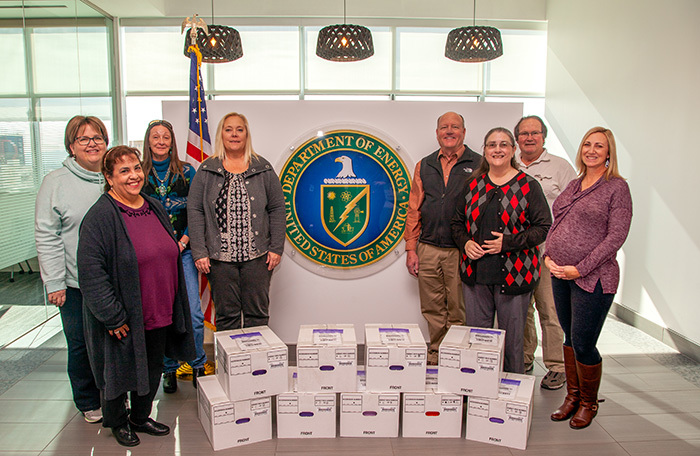 LAS VEGAS – The EM Nevada Program recently completed environmental corrective actions at 70 sites where historic nuclear weapon system tests and support activities contaminated surface and shallow subsurface soil and debris. The sites are regulated by the Federal Facility Agreement and Consent Order (FFACO), a legally-binding agreement signed in 1996 that outlines a schedule of cleanup and monitoring commitments. Responsibility for long-term stewardship of the 70 FFACO sites, located on the Tonopah Test Range and Nevada Test and Training Range, is being transferred to DOE’s Office of Legacy Management (LM). Records management is key to the ongoing transfer process scheduled for completion later this year. Pictured are members of the team with the EM Nevada Program and environmental program services contractor Navarro, who recently shipped the first group of records to LM. From left, Marla Libidinsky, EM Nevada Program; Alicia Tauber and Mary Page, Navarro; Pamela Bailey, EM Nevada Program; Scott Kranker, Katharine Wickham, and Patrick Matthews, Navarro; and Tiffany Gamero, EM Nevada Program.
-Contributors: Dona Merritt, Christy Morris, and Ari Rosenberg
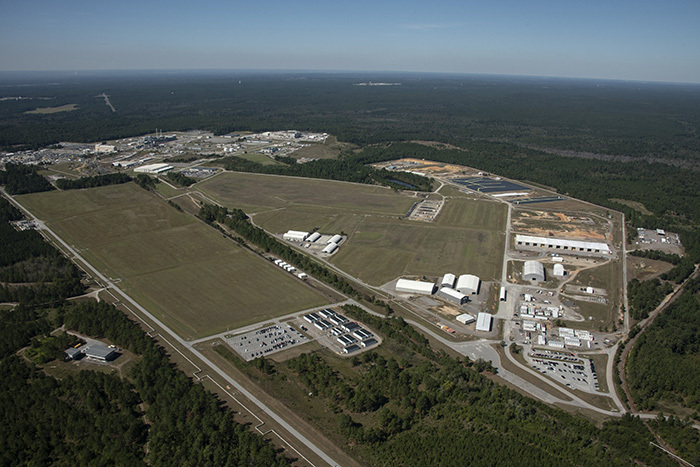 An aerial view of the Savannah River Site solid waste management program area.
AIKEN, S.C. – A recent DOE assessment found no deficiencies in EM’s solid waste program at the Savannah River Site (SRS).
DOE’s Office of Enterprise Assessments (EA) performs independent assessments for DOE senior leadership that report on whether national security material and information assets are appropriately protected and whether Department operations provide for the safety of DOE employees and the public.
The assessment of the SRS Solid Waste Program was performed to verify compliance in characterizing and dispositioning radioactive waste, such as low-level, mixed, and transuranic waste.
"Overall, SRS’s waste management program ensures proper characterization, packaging, and shipping of radioactive waste for disposal, and both the DOE Office of Environmental Management Savannah River Operations Office (DOE-SR) and the National Nuclear Security Administration (NNSA) Savannah River Field Office (NNSA-SRFO) maintain adequate operational awareness of the radioactive waste management activities," the report says.
The solid waste program supports EM and NNSA missions at the site, including projects to down blend plutonium and expedite removal of the material from the state.
“Disposing of contaminated waste from facilities in underground trenches and vaults, or other approved safe methods, along with monitoring to prevent unintentional spread of contamination from waste disposal units, is our mission,” said Kerri Crawford, solid waste programs manager at EM contractor Savannah River Nuclear Solutions (SRNS). “The solid waste management program at SRS is vital to the safety and security of our nation.”
The SRS Solid Waste Program performed a thorough self-assessment to prepare for the EA visit, including procedure and document reviews, and staff interviews to identify needed adjustments.
Janice Lawson, deputy vice president for EM operations at SRNS, expressed appreciation for the work of SRNS employees to prepare for the assessment.
“The report commends our structure and consistency, and I want to thank our employees for their continued commitment to maintaining excellence,” Lawson said.
-Contributor: Lindsey MonBarren
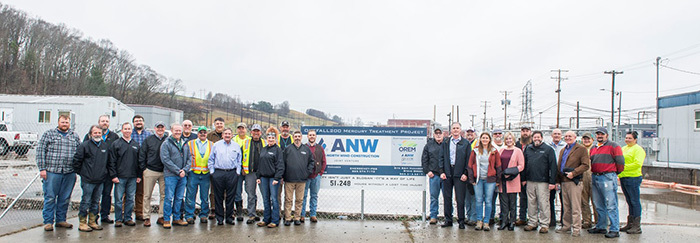 Oak Ridge workers celebrate a safety milestone on the Outfall 200 Mercury Treatment Facility project.
OAK RIDGE, Tenn. – Oak Ridge workers building the Outfall 200 Mercury Treatment Facility recently achieved a safety milestone: zero lost workday cases and zero recordable injuries since mobilizing for the project six months ago.
The facility is vital to help fulfill EM’s regulatory commitments to reduce mercury levels in the East Fork Poplar Creek and enable large-scale cleanup and demolition to begin at the Y-12 National Security Complex. Outfall 200 is where the headwaters originate for the Upper East Fork Poplar Creek at Y-12.
Employees with Oak Ridge contractor APTIM – North Wind Construction (ANW) contribute to the project’s safety culture in a variety of ways. They conduct daily safety briefings, which provide opportunities for employee discussion and feedback; participate in continuous site- and task-specific training; implement appropriate controls from hazard recognition and analysis; and conduct regular site safety inspections.
The project also benefits from the Outfall 200 Health and Safety Committee, which convenes at least monthly. The group is comprised of representatives from EM, ANW management, and the project.
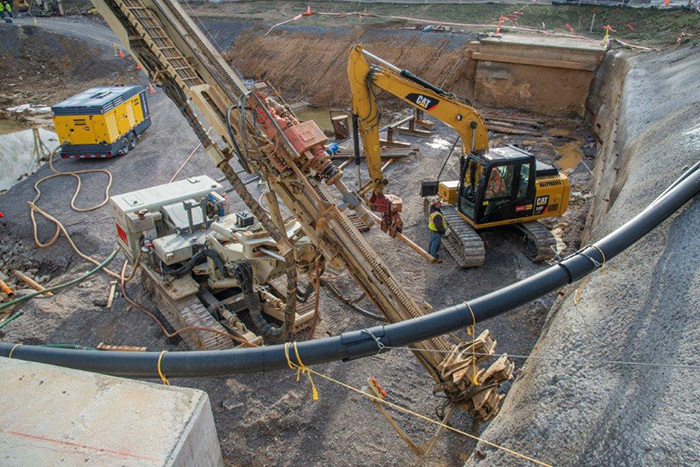 Crews at the headworks site of the Outfall 200 Mercury Treatment Facility are excavating for the construction of foundations.
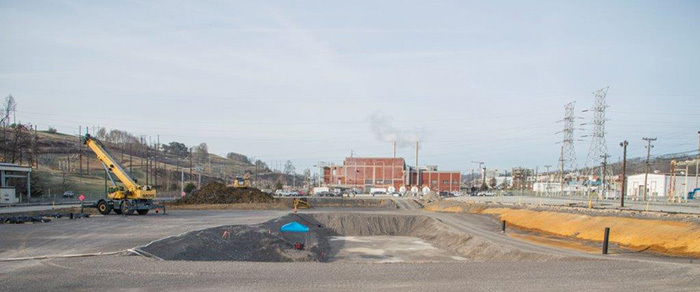 The site of the treatment plant for the Outfall 200 Mercury Treatment Facility, where workers are preparing to install concrete.
The treatment facility includes a headworks facility and a treatment plant connected by a pipeline nearly a mile long. The headworks facility will capture creek flow on the west end of Y-12, store excess stormwater collected during large rainfalls, remove grit, and pump water through the pipeline to the treatment plant on the east side of Y-12. The treated water will then flow into the creek.
Crews at the headworks site are currently excavating for the construction of foundations. They are installing a wall designed to stabilize and support the surrounding soil that will be 110 feet long and 35 feet high when complete. At the treatment plant site, crews are installing materials and structures needed to pour concrete.
When the treatment facility is operational, it will limit and control potential mercury releases as crews take down massive Cold War buildings and address soils — activities that may disrupt the mercury-contaminated area on the west end of Y-12. The facility is designed to treat up to 3,000 gallons of water per minute and includes a 2-million-gallon storage tank to collect stormwater.
-Contributor: Anne Smith
|